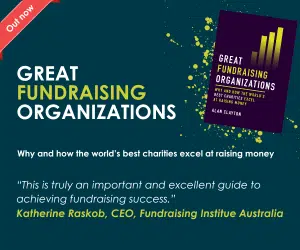The new norm
A new report answers some very important questions, but leaves quite a few still begging.
A few days ago I went to the launch of Managing in the New Normal 2015, the latest in a series of yearly reports from the Institute of Fundraising (IoF), Charity Finance Group (CFG) and the accountants PWC.
It makes for an interesting read. On the downside there’s increasing competition and ageing donor bases amongst the main problems fundraisers face.
On the upside however, attrition is reported as stable or down, nearly half of respondents plan to start fundraising in new areas and acquisition rates for committed givers are slightly up. Good news indeed.
Missing Pieces
Like most reports though, Managing in the New Normal begs further questions, and didn’t ask a few that it should.
How many managers, for instance, are planning to increase the number of donors as well as (or instead of) their number of fundraisers? Seeing as more donors should equal more money then the answer matters as much as how many people are planning skills training for fundraisers (which is thirty-five percent, if you’re wondering).
Similarly, how many are planning to increase the value of the donors they already have? Comparing the answer to this with the answers about getting more donors would tell us about the balance between acquisition and development, which in turn has implications for the nature of competition.
Nor does the report really tell us what to do next and, to be fair, it doesn’t set out to do this. But if it’s not going to sit on a dusty shelf then we should read it with an eye to what we might do with all these nuggets of insight. Here are some suggestions:
Age, competition and more
If you’re worried about competition then stop because there’s absolutely nothing you can do about the big picture. You’re not the only charity after your donors’ cash, period. What you should do is worry about the micro picture and the other charities your donors are supporting as that’s where the real, tangible competition lies.
Ask how much you’re focused on developing internal capacity and how much you’re focused on developing your donors. More skills training for fundraisers is very good per se but not necessarily at the expense of recruiting and retaining more donors.
Don’t be too obsessed with an ageing donor base. A file stuffed with sixty-fives and overs is still a hugely valuable asset; they’re generous compared to their juniors and many will live twenty years before leaving a legacy. Think about getting the most from what you already own, as much as wondering what you could get out of something you don’t yet have.
Finally, don’t be lulled into thinking that if everyone’s doing it then you should jump aboard. This is a report on what charities say they’re thinking and planning and it doesn’t mean the same thing is right for all.
Advertisement
Read it and smile (cautiously)
You should read the report, there’s a lot to be had from it and the IOF-CFG-PWC trio have done a really good job. Interestingly, when the first in the series was done in 2008 at the height of the credit crunch it was called ‘Managing in a Downturn’. The new title is far more cheerful: Let’s hope that next year it can be called Managing in A Golden Age.
Andy Taylor is a consultant at The Desired Effect and has over ten years experience as a fundraising director in large national and international charities. A direct marketing specialist, he’s a regular contributor to the voluntary sector media.




